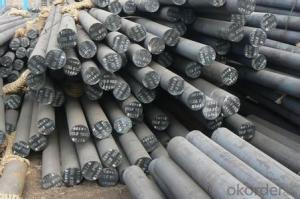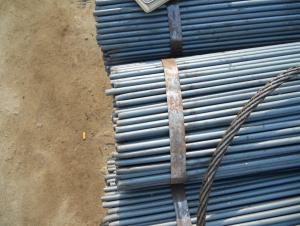Alloy Steel SCr420H AISI 5120
- Loading Port:
- Shanghai
- Payment Terms:
- TT OR LC
- Min Order Qty:
- 30 m.t.
- Supply Capability:
- 120000 m.t./month
OKorder Service Pledge
OKorder Financial Service
You Might Also Like
AISI 5120 Alloy Steel SCr420H
Specification
1, Diameter: 8mm-250mm rounds
5mm-9mm rods
2, Length: 2m, 3m, 5.8m, 6m or customized
3, Standard: GB, ASTM, AISI, SAE, DIN, JIS, EN
OEM technology - send detailed technical parameters for accurate quotation.
2, Produce Process: smelt iron - EAF smelt billet - ESR smelt billet -
hot rolled or forged to get the steel round bar and plate
3, Heat Treatment: annealing, normalizing, tempering, quenching
4, Surface Treatment: Black, Polished, Galvanized
5, Quality Assurance: We accept third party inspection for all orders.
You can ask testing organizations such as SGS, BV, etc. to test our products before shipping.
Chemical Composition
| C | Si | Mn | Cr | S | P | Ni | Cu |
| 0.18~0.24 | 0.17~0.37 | 0.50~0.80 | 0.70~1.00 | ≤0.035 | ≤0.035 | ≤0.030 | ≤0.030 |
Products Show
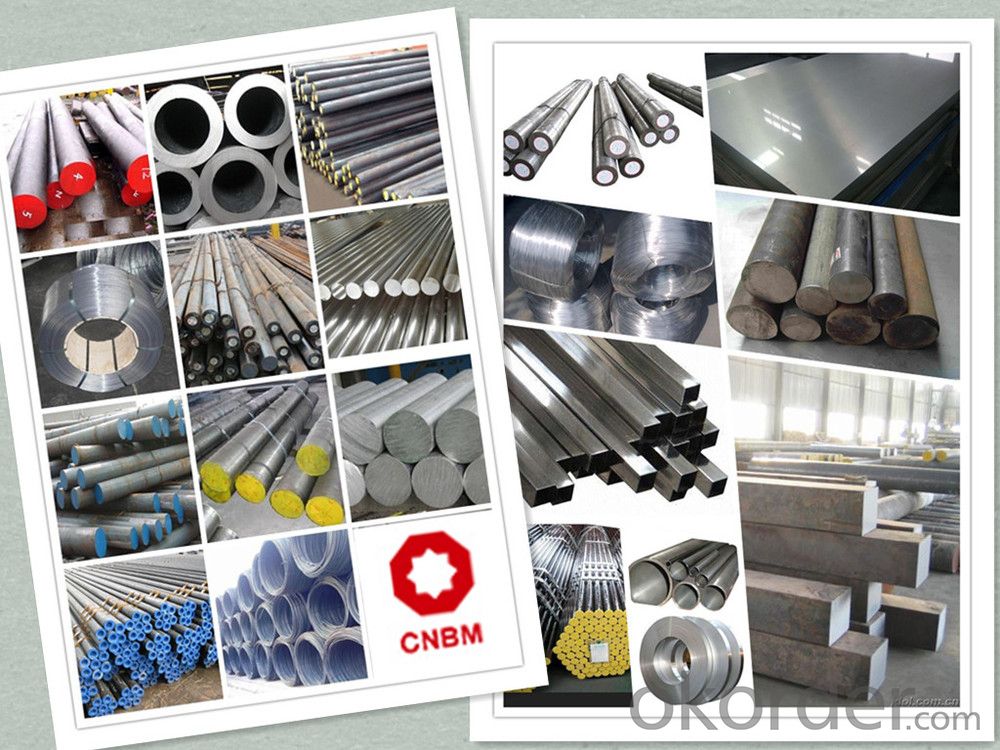
Product Overviews
Description | Carbon Steel Rod/Carbon Steel Bar,carbon steel rod,carbon steel shaft,mild steel bar, Mild steel shaft,ms bar | |
Material | ASTM | 1005, 1006, 1008, 1010, 1015, 1020, 1025, 1030, 1035, 1040, 1045, 1050, 1055, 1060, 1065, 1070, 1080, 1084, 1016, 1022 |
DIN | Ck10, Ck15, Ck22, Ck25, Ck30, Ck35, Ck40,Ck45, Ck50, 30Mn4, 40Mn4 | |
BS | 040A04, 095M15, 045M10, 080A40, 045M10, 080M50 | |
JIS | S09CK, S9CK, S10C, S15C, S20C, S25C, S30C, S35C, S40C, S45C, S50C, S55C, S58C, SB45, S30C, S40C, S45C, S53C | |
Standard | GB/T799, ASTM A29, A108, A321, A575, BS970, DIN1652, JIS G4051 | |
| Section shape | Round, square, hexagonal, flat, angle | |
| Surface | Black painted, galvanized | |
Specifications | Round bar | Diameter: 4mm~1200mm |
Angle bar | Size: 3mm*20mm*20mm~12mm*800mm*800mm | |
Square bar | Size: 4mm*4mm~100mm*100mm | |
Flat bar | Thickness: 2mm~100mm | |
Width: 10mm~500mm | ||
| Hexagonal | Size: 4mm~800mm | |
Length | 2m, 4m, 5.8m, 6m, 11.8m, 12m or as required. | |
Work Shop
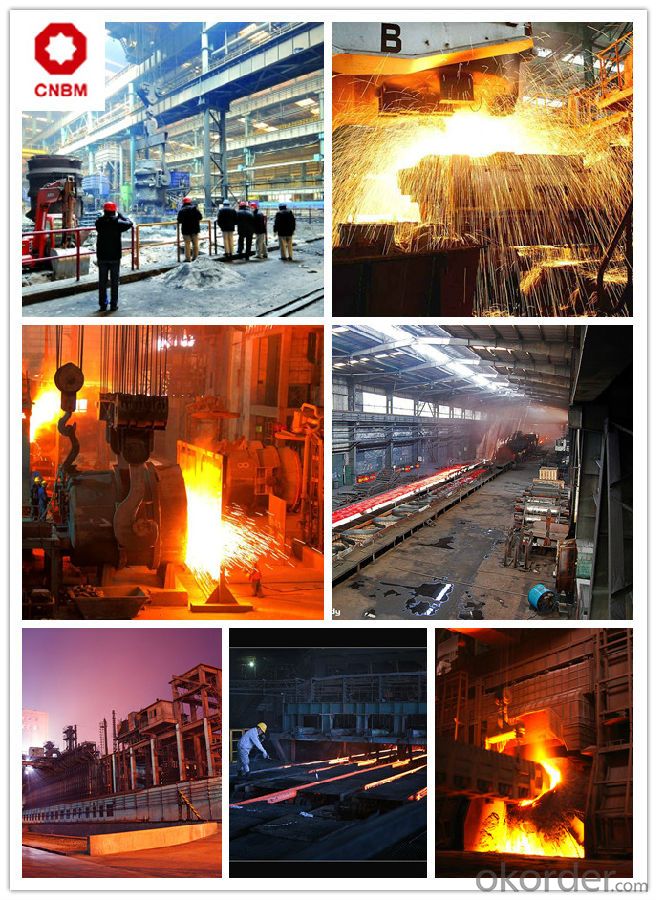
Company Information
CNBM International Corporation is the most important trading platform of CNBM group.
Whith its advantages, CNBM International are mainly concentrate on Cement, Glass, Iron and Steel, Ceramics industries and devotes herself for supplying high qulity series of refractories as well as technical consultancies and logistics solutions.

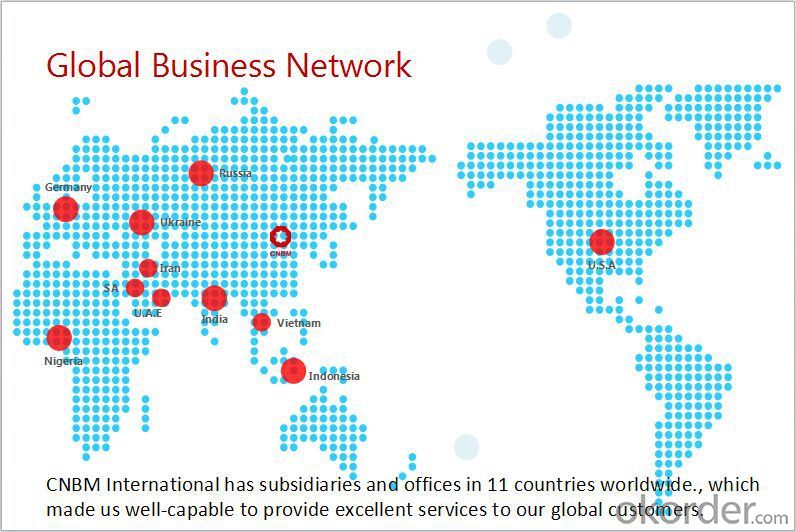
FAQ
1, Your advantages?
professional products inquiry, products knowledge train (for agents), smooth goods delivery, excellent customer solution proposale
2, Test & Certificate?
SGS test is available, customer inspection before shipping is welcome, third party inspection is no problem
3, Factory or Trading Company?
CNBM is a trading company but we have so many protocol factories and CNBM works as a trading department of these factories. Also CNBM is the holding company of many factories.
4, Payment Terms?
30% TT as deposit and 70% before delivery.
Irrevocable L/C at sight.
5, Trading Terms?
EXW, FOB, CIF, FFR, CNF
6, After-sale Service?
CNBM provides the services and support you need for every step of our cooperation. We're the business partner you can trust.
For any problem, please kindly contact us at any your convenient time.
We'll reply you in our first priority within 24 hours.
Packaging & Delivery
1, Packaging: seaworthy package or as required
2, Delivery: 35-45 days or based on quantity
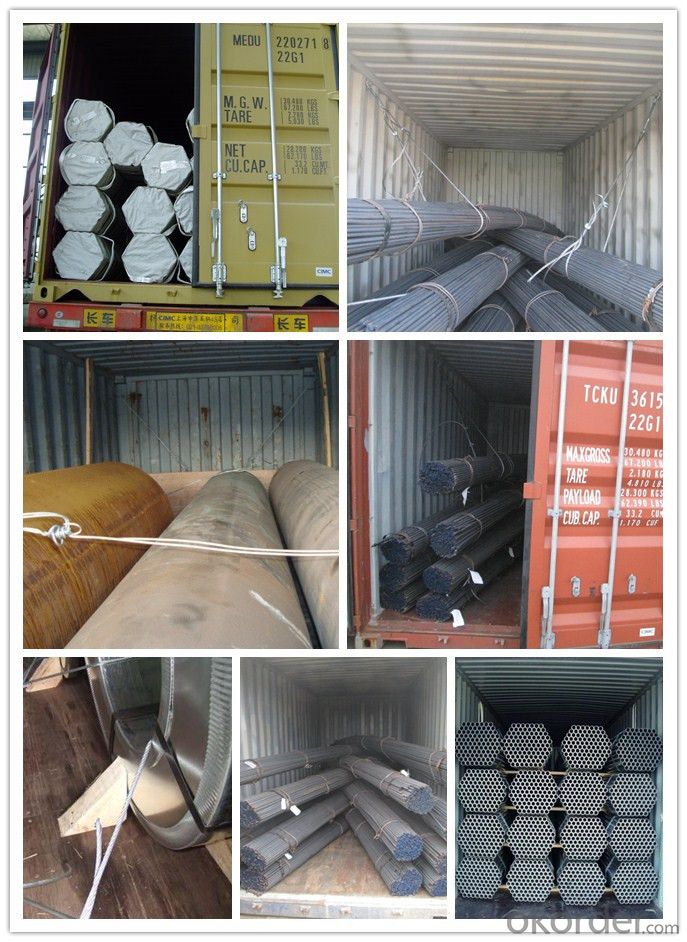
- Q:Can steel round bars be coated or painted?
- Yes, steel round bars can be coated or painted. Coating or painting steel round bars can provide protection against corrosion, enhance aesthetics, and improve durability.
- Q:How are steel round bars used in the construction of high-rise buildings?
- Steel round bars are commonly used in the construction of high-rise buildings due to their strength, durability, and versatility. These bars are typically made of carbon steel, which has excellent mechanical properties and can withstand high loads and pressures. In the construction of high-rise buildings, steel round bars are primarily used in reinforced concrete structures. They are commonly used as reinforcement in concrete beams, columns, and slabs. The bars are embedded in the concrete to provide additional strength and stiffness to the overall structure. One of the main advantages of using steel round bars is their ability to resist tension forces. Concrete is strong in compression but weak in tension, so the steel bars act as tension reinforcement, preventing the concrete from cracking or failing under tension loads. This helps to enhance the structural integrity and overall safety of the building. Additionally, steel round bars can be easily bent, shaped, and welded, allowing for flexible design and construction possibilities. They can be customized to specific lengths and diameters to suit the requirements of the building project. This versatility makes them ideal for constructing various structural elements, such as beams and columns, which need to be precisely engineered to support the weight and stresses of a high-rise building. Moreover, steel round bars have excellent resistance to corrosion, which is crucial in the construction of high-rise buildings that are exposed to various environmental elements. The corrosion-resistant properties of steel ensure the long-term durability and lifespan of the structure. Overall, steel round bars play a vital role in the construction of high-rise buildings by providing strength, durability, and flexibility to the reinforced concrete structures. They enhance the overall structural integrity, safety, and longevity of the building, making them an essential component in modern construction practices.
- Q:What is the maximum hardness achievable for steel round bars?
- The maximum hardness achievable for steel round bars depends on various factors such as the composition of the steel, the heat treatment process, and the desired properties for the specific application. Generally, steel can achieve a maximum hardness of around 65 HRC (Rockwell Hardness Scale C) or higher. This level of hardness is typically obtained through processes like quenching and tempering. Quenching involves rapidly cooling the steel from a high temperature to room temperature, which results in a hardened structure. Tempering is then performed to reduce the brittleness and improve the toughness of the steel while maintaining a high level of hardness. It's important to note that increasing the hardness of steel beyond a certain point may lead to reduced toughness and increased brittleness. Therefore, the maximum achievable hardness should be balanced with the desired properties for the specific application, such as strength, ductility, and resistance to wear or impact.
- Q:Can steel round bars be used in the textile industry?
- Steel round bars can indeed be used in the textile industry, albeit in limited applications. While textiles are primarily made from natural or synthetic fibers, steel round bars can be utilized in the machinery and equipment used in textile production. These bars are often used to construct frames, supports, and other structural components of textile machinery. For example, steel round bars can be used to build the frames of looms, which are used to weave fabrics. They can also be used in the construction of spinning machines, knitting machines, and other textile manufacturing equipment. Additionally, steel round bars can be used as a base or support for textile drying racks, storage systems, or conveyor systems. In these applications, the strength and durability of steel make it a suitable material for withstanding the demands of industrial textile production. However, it is important to note that steel round bars are not directly incorporated into the fabric or textile products themselves.
- Q:Can steel round bars be used for making steering linkages?
- Making steering linkages is one application where steel round bars can be used. Steel round bars have a wide range of uses in automotive and mechanical engineering due to their strength, durability, and resistance to wear and tear. Steering linkages play a crucial role in a vehicle's steering system as they transmit the steering input from the steering wheel to the wheels. By using steel round bars, the necessary strength and rigidity are provided, ensuring efficient and reliable steering performance. However, it is important to consider other factors like specific design requirements, weight considerations, and desired level of flexibility or torsional properties when choosing the appropriate type and size of steel round bar for steering linkages.
- Q:How do steel round bars compare to stainless steel round bars?
- Steel round bars and stainless steel round bars have some key differences that make them suitable for different applications. One of the main differences between steel and stainless steel round bars is their composition. Steel is primarily made of iron, with small amounts of carbon and other elements. Stainless steel, on the other hand, is an alloy composed of iron, chromium, and often other elements like nickel or molybdenum. This composition gives stainless steel its unique properties, such as corrosion resistance. In terms of strength, both steel and stainless steel round bars can be manufactured to have high tensile strength. However, stainless steel generally has higher tensile strength compared to regular steel, making it more suitable for applications that require additional strength and durability. Another important difference is their resistance to corrosion. Stainless steel round bars have excellent corrosion resistance due to the presence of chromium in their composition. This makes them ideal for applications where they will be exposed to moisture, chemicals, or other corrosive environments. Steel round bars, on the other hand, are more susceptible to rust and corrosion and may require additional protective coatings in such environments. In terms of cost, steel round bars are generally more affordable compared to stainless steel round bars. The higher cost of stainless steel is due to its unique properties and the additional alloying elements required in its production. Both steel and stainless steel round bars have their own advantages and applications. Steel round bars are commonly used in construction, manufacturing, and general-purpose applications where corrosion resistance is not a primary concern. Stainless steel round bars, on the other hand, find extensive use in industries such as food processing, chemical processing, medical equipment, and marine applications, where corrosion resistance is crucial. In summary, the choice between steel round bars and stainless steel round bars depends on the specific requirements of the application. Steel round bars are more affordable but may require additional corrosion protection, while stainless steel round bars offer superior corrosion resistance and strength.
- Q:What are the disadvantages of using steel round bars?
- Using steel round bars in certain applications has several drawbacks. Firstly, they are relatively heavy compared to materials like aluminum or plastic, which can be problematic when weight restrictions or easy transportation are important factors. Secondly, steel round bars are prone to corrosion, particularly in environments with high moisture, humidity, or exposure to certain chemicals. This can cause the material to degrade over time, reducing its strength and durability. To address this issue, additional measures such as coatings or regular maintenance may be necessary, increasing the overall cost and effort. Moreover, steel round bars may not be suitable for applications that require electrical insulation due to their conductivity. This can be a disadvantage when electrical conductivity needs to be avoided. Lastly, steel round bars may not be as visually appealing as materials like wood or decorative metals. While this may not be a significant drawback in some applications, it can be a disadvantage in situations where aesthetics are important, such as architectural or interior design projects. In conclusion, while steel round bars have widespread use and offer numerous advantages such as high strength and durability, it is crucial to consider these disadvantages in specific applications to ensure the most suitable choice of materials.
- Q:What are the advantages of using high-speed steel round bars?
- High-speed steel (HSS) round bars have several advantages. Firstly, they offer excellent hardness, allowing them to withstand high temperatures and wear. This makes them suitable for cutting tools and machine parts that undergo intense friction and heat. Additionally, HSS round bars have superior toughness, enabling them to resist chipping and breaking during heavy-duty applications. Furthermore, their high thermal conductivity helps dissipate heat efficiently, preventing damage to the material being worked on and prolonging tool life. Lastly, HSS round bars have good dimensional stability, ensuring accurate and precise machining results.
- Q:Can steel round bars be used in the agriculture industry?
- Yes, steel round bars can be used in the agriculture industry. They are commonly used in various applications such as constructing farm equipment, fencing, and building structures. Steel round bars are known for their strength and durability, making them suitable for heavy-duty tasks in the agriculture sector. Additionally, steel round bars can withstand harsh weather conditions and resist corrosion, ensuring their longevity and reliability in agricultural settings. Overall, steel round bars are a versatile and practical choice for the agriculture industry due to their strength, durability, and resistance to environmental factors.
- Q:What is the difference between a bright and a precision ground steel round bar?
- A bright steel round bar and a precision ground steel round bar are two different types of steel bars with distinct characteristics and manufacturing processes. The main difference between a bright steel round bar and a precision ground steel round bar lies in their surface finish and manufacturing tolerances. A bright steel round bar, also known as a bright mild steel bar or a bright mild steel round bar, undergoes a process called bright drawing. This process involves pulling the steel bar through a die to achieve a smooth and shiny surface finish. As a result, bright steel round bars have a highly polished appearance and a clean, smooth texture. They are commonly used in decorative applications, such as in the manufacturing of furniture, automotive accessories, and architectural elements. On the other hand, a precision ground steel round bar is manufactured with tight dimensional tolerances and precise surface finishes. These bars are typically made through the process of precision grinding, where the steel bar is machined to achieve a specific diameter and surface finish. Precision ground steel round bars are known for their accuracy and consistency in size, making them suitable for applications that require close tolerance and high precision, such as in the manufacturing of bearings, shafts, and hydraulic cylinders. In summary, the key difference between a bright steel round bar and a precision ground steel round bar lies in their surface finish and manufacturing tolerances. A bright steel bar has a polished appearance and is used primarily for decorative purposes, while a precision ground steel bar is machined to precise dimensions and is suitable for applications that require high precision and close tolerances.
1. Manufacturer Overview |
|
|---|---|
| Location | |
| Year Established | |
| Annual Output Value | |
| Main Markets | |
| Company Certifications | |
2. Manufacturer Certificates |
|
|---|---|
| a) Certification Name | |
| Range | |
| Reference | |
| Validity Period | |
3. Manufacturer Capability |
|
|---|---|
| a)Trade Capacity | |
| Nearest Port | |
| Export Percentage | |
| No.of Employees in Trade Department | |
| Language Spoken: | |
| b)Factory Information | |
| Factory Size: | |
| No. of Production Lines | |
| Contract Manufacturing | |
| Product Price Range | |
Send your message to us
Alloy Steel SCr420H AISI 5120
- Loading Port:
- Shanghai
- Payment Terms:
- TT OR LC
- Min Order Qty:
- 30 m.t.
- Supply Capability:
- 120000 m.t./month
OKorder Service Pledge
OKorder Financial Service
Similar products
New products
Hot products
Related keywords






























